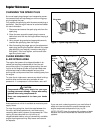
TIPS FOR BETTER CHIPPING
DO’s
1. Prune tree limbs and large branches to limit their size
to the maximum diameter allowed. Pruning tree
limbs and branches close to the main portion of the
limb or branch will make feeding into the chipper
cone easier, and will help you maintain control as the
material is drawn into the chipper block.
2. Manually rotate large, hard, or dried-out tree limbs that
tend to resist chipping. Rotating as well as alternate-
ly inserting and retracting large, hard, or dried-out
limbs allows the chipper knives to “take smaller
bites” out the of material being chipped.
3. Always maintain adequate control of the tree limbs
and branches being fed into the chipper cone to pre-
vent them from whipping around and causing injury
to you or damage to the cone. Larger limbs and
branches may have a tendency to kick back toward
the operator, so always be alert as you feed materi-
als into the cone.
4. Group bunches of smaller branches together for easi-
er feeding.
14
PROPER TECHNIQUE FOR CHIPPING
Always maintain a stable, well-balanced stance to one
side of the unit when operating the chipper/ shredder.
Never stand directly in front of the chipper cone when
performing chipping operations, since occasional kick-
backs may occur, and result in you being struck by the
tree limb or branch being kicked back.
Hold tree limbs and branches carefully to maintain con-
trol as they are being fed into the chipper cone, letting
the self-feeding action of the unit pull the material in.
Never wrap your fingers around tree limbs and branches
so tightly that you can’t let go quickly if the tree limb or
branch is suddenly pulled into the chipper block.
Using your Chipper/Shredder
Figure 11. Correct Chipping Stance
DON’Ts
1. If the material being chipped does not easily feed into
the chipper, do not force it into the chipper. If the
material to be chipped is extremely hard, kicks back
forcefully, or cannot be easily controlled while it is
being fed into the unit, remove the material immedi-
ately and set it aside. The material may not be suit-
able for chipping or you may need to sharpen the
chipper blades to process the material. If normal
chipping operation begins to require additional feed-
ing force to process material, the chipper knives
may be in need of routine sharpening. Consult the
maintenance and service section of this manual for
sharpening instructions, or take your unit to an
authorized service center for prompt, reliable ser-
vice.
2. Never use the chipper/shredder to chip very hard, dry
materials such as kiln-dried dimensional lumber
(2x4’s, 1x2’s, etc.), or other building and lumber yard
materials.
3. Never use the chipper/shredder to chip pressure-treat-
ed wood products such as landscape timbers, fence-
posts, or other outdoor building or landscaping lum-
ber products.
4. Avoid chipping long pieces (over 6') because the outer
end can whip in a circular motion and strike you or
bystanders, causing personal injuries.
5. Never place your hands in the chipper cone to feed
short lengths of material. As the material is chipped,
short lengths may be pushed into the chipper with
another tree limb.


















